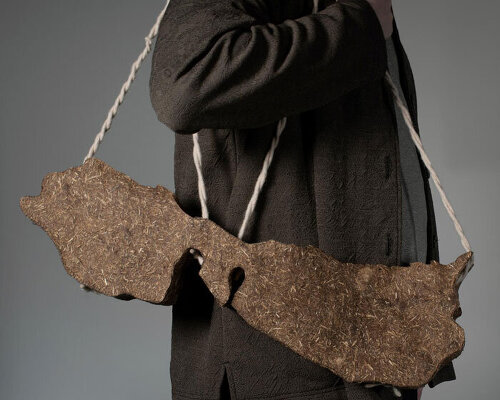reductio ad lermaense bag collection uses bulrush biomaterials
Reductio ad Lermaense is a collection of bags made from bulrush-based biomaterials that examine the ecological, cultural, and political history of Mexico’s Ciénegas del Lerma from 1870 to the present. The Ciénegas del Lerma once represented the largest wetland in Mexico’s central plateau. Today, only 11% remains after more than 170 years of industrial pollution, water extraction, and other anthropogenic pressures. These changes have disrupted the wetland’s biodiversity and weakened traditions such as bulrush weaving, historically practiced by local artisans. As ecosystem deterioration has progressed, bulrush (Typha latifolia) has shifted from a valued resource to an invasive species.
The project by Manuel Díaz Tufinio reinterprets this material condition through design. Using bulrush-derived biomaterials, the designer developed three leather-like bags that chart the progressive loss of the wetland over time. Rather than proposing a solution, the series functions as a critical design artifact that reflects the ecological transformations of the Lerma lagoons.
all images by Manuel Díaz Tufinio unless stated otherwise
cartographies of Mexico’s last wetlands by manuel diaz tufinio
Designer Manuel Díaz Tufinio crafts each bag in correspondence to a specific moment in Mexico’s wetlands history. The 1870 bag (60 × 20 × 5 cm) references the first attempts to drain the bodies of water by the Mexican liberal government. The 1951 bag (28 × 17 × 5 cm) is shaped from a map that coincided with the creation of the Lerma System, a vast network of canals and pipelines that diverted water to Mexico City. The 2025 bag (10 × 8 × 5 cm) represents the current state of the Chimaliapan lagoon, reduced to a fraction of its original size and capable of holding only minimal objects. Their progressively smaller storage capacities serve as a metaphor for the loss of ecological function.
The title Reductio ad Lermaense references both the endangered Lake Lerma axolotl (Ambystoma lermaense) and the rhetorical device reductio ad absurdum. This dual reference underscores the absurdity of the wetland’s steady disappearance and the intertwined loss of species, materials, and cultural practices.
Reductio ad Lermaense is a bag collection made from bulrush-based biomaterials | 1870 bag
the project explores the ecological and cultural history of Mexico’s Ciénegas del Lerma | 1951 bag
industrial pollution and water extraction have reshaped the wetland’s landscape | 2025 bag
centuries-old bulrush weaving traditions have weakened with ecosystem decline | image by Anne Kinnunen
bio-based cellulose leather combines bulrush fibres, seeds, Microcrystalline cellulose (MCC) and Carboxymethyl cellulose (CMC)
the design transforms bulrush into a leather-like biomaterial for new applications
materials samples
outlines of the lagoons are taken from hydrological cartographies
the bio-based material’s elastic characteristics are similar to those of leather
biomaterial gets laser cut to achieve more defined silhouettes
project info:
name: Reductio Ad Lermaense
designer: Manuel Díaz Tufinio
materials: Bulrush fibres, seeds (Typha latifolia), Microcrystalline cellulose (MCC), Carboxymethyl cellulose (CMC), Wool
thesis supervisor: Eeva Berglund
advisors: Anna van der Lei, Ena Naito
photographer: Manuel Díaz Tufinio, Anne Kinnunen
designboom has received this project from our DIY submissions feature, where we welcome our readers to submit their own work for publication. see more project submissions from our readers here.
edited by: christina vergopoulou | designboom
The post bag collection uses bulrush biomaterials to map mexico’s vanishing wetlands appeared first on designboom | architecture & design magazine.

